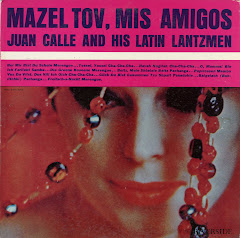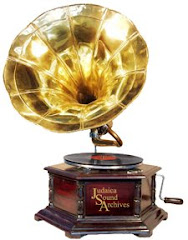But for our review... read on:
On December 11th, The Idelsohn Society for Musical Preservation rocked New York with the sounds that once reverberated everywhere across the city. Many of the artists we have met over the past eight years took the stage one more time at Joe's Pub, playing for a sold out crowd who packed the club even as the heavens opened outside. By the line to get in, you would have thought the Beatles had reformed. Sodden masses clad in North Face, braving the elements to hear Irving Fields, El Avram, Gershon Kingsley, and Sol Zim hit it hard. The gig itself was an eighty-five minute roller coaster through time. 93-year old Irving Fields kicking things off with an animated version of Miami Beach Rhumba segueing into his Hava Nagila, replete with signature finger pyrotechnics which bought the audience to their feet. We could have closed the show right there. Irving felt the love and told the audience that they "could not understand how fulfilling it was to hear the applause of a crowd at his age."
 Irving had set the bar high, but Avram Grobard, the mighty El Avram, had no fear, unleashing his ridiculously addictive "El Avram's Theme" on the audience who surely left the show with the chorus rebounding through their minds. A remarkable performance from a master of stagecraft.
Irving had set the bar high, but Avram Grobard, the mighty El Avram, had no fear, unleashing his ridiculously addictive "El Avram's Theme" on the audience who surely left the show with the chorus rebounding through their minds. A remarkable performance from a master of stagecraft. Moog pioneer Gershon Kingsley took the audience on a journey into the Hebraic origins of his anthem, "Popcorn" leaving the stage to a flute driven tribute laid down by band leader, Paul Shapiro who was a giant throughout.
Moog pioneer Gershon Kingsley took the audience on a journey into the Hebraic origins of his anthem, "Popcorn" leaving the stage to a flute driven tribute laid down by band leader, Paul Shapiro who was a giant throughout. The show was closed by Sol Zim, the last in a royal lineage of five generations of Cantors whose career was inextricably changed when he attended a KISS concert at Madison Square Garden in the seventies. Sol toyed with the audience with his thumping rendition of Am Yisrael Chai, gyrating his crotch through the chorus, dragging the audience through the chorus, and yes, knickers were thrown...
The show was closed by Sol Zim, the last in a royal lineage of five generations of Cantors whose career was inextricably changed when he attended a KISS concert at Madison Square Garden in the seventies. Sol toyed with the audience with his thumping rendition of Am Yisrael Chai, gyrating his crotch through the chorus, dragging the audience through the chorus, and yes, knickers were thrown... The gig was a blast. For the audience, and most importantly, for the performers who rocked so hard, killing in their own way, and challenging the audience to consider both their individual pasts and their sense of collective history. Thanks also to Jessi Klein, Jody Rosen, and Kandia Crazy Horse, who toasted Streisand/Diamond duets, Jewface sheet music, and The Temptations doing Fiddler in that order... Nextbook and Alana Newhouse for hosting the afterparty, and Jackie Hoffman who channeled the spirits of Belle Barth and Ruth Wallis in inimitable fashion. We are planning a much bigger show in New York in Summer '09. But next up, a west coast gig... San Francisco, February 5th....
The gig was a blast. For the audience, and most importantly, for the performers who rocked so hard, killing in their own way, and challenging the audience to consider both their individual pasts and their sense of collective history. Thanks also to Jessi Klein, Jody Rosen, and Kandia Crazy Horse, who toasted Streisand/Diamond duets, Jewface sheet music, and The Temptations doing Fiddler in that order... Nextbook and Alana Newhouse for hosting the afterparty, and Jackie Hoffman who channeled the spirits of Belle Barth and Ruth Wallis in inimitable fashion. We are planning a much bigger show in New York in Summer '09. But next up, a west coast gig... San Francisco, February 5th....














































+img037+copy.jpg)




